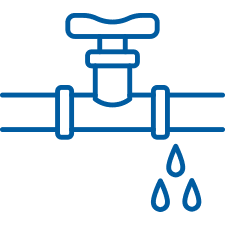Your foundation may seem indestructible, but it’s more vulnerable than you think—especially when well-meaning homeowners make costly mistakes that affect soil stability, drainage, and structural integrity. At Perma-Seal, we’ve seen it all. Here’s a breakdown of the top 5 common missteps that can slowly (and silently) damage your home’s foundation.
1. Improper Drainage Around the Home
Why it matters:
Water is the #1 enemy of a healthy foundation. If water isn’t being directed away from your home properly, it can pool near the foundation and saturate the soil. Over time, this creates hydrostatic pressure, which pushes against basement walls, or it leads to soil erosion, which removes support from underneath the foundation.
Mistakes to avoid:
- Missing or broken gutters/downspouts
- Downspouts draining too close to the foundation (less than 6 feet away)
- Grading that slopes toward the home instead of away
Pro Tip: Extend your downspouts at least 6–10 feet away from the house and ensure the yard is graded to slope away from the foundation by at least 6 inches over 10 feet.
2. Overwatering Landscaping Near the Foundation
Why it matters:
Excessive watering—especially near flower beds or lawns next to the house—can oversaturate the soil and cause it to expand. This can lead to heaving or differential settlement, where only part of the foundation sinks or lifts, causing cracks in walls and floors.
Mistakes to avoid:
- Irrigation systems that spray water directly against the house
- Watering daily, regardless of weather or soil saturation
- Installing moisture-loving plants too close to foundation walls
Pro Tip: Use drip irrigation or timers and keep water sources at least 12–18 inches away from the foundation walls. Consider drought-tolerant plants in beds nearest your home.
3. Planting Trees Too Close to the Foundation
Why it matters:
Tree roots don’t just grow outward—they grow downward, seeking moisture. In doing so, they can displace soil or even drain moisture unevenly, leading to soil shrinkage and foundation movement, especially in expansive clay soils.
Mistakes to avoid:
- Planting large trees (oak, elm, maple) within 10–20 feet of your home
- Ignoring signs of root encroachment, like cracked sidewalks or buckling soil
Pro Tip: Plant trees at least half their mature height away from the foundation. A 40-foot tree? Keep it 20+ feet from your house.
4. Ignoring Minor Foundation Cracks
Why it matters:
A small crack may not seem like a big deal—but cracks are like a fever: they’re symptoms of a larger problem. Many homeowners wait too long to call a professional, only to find the damage has progressed from minor settlement to major structural movement.
Mistakes to avoid:
- Sealing cracks with hardware store caulk without understanding the cause
- Assuming horizontal or stairstep cracks are cosmetic
- Skipping annual inspections of basement walls and floors
Pro Tip: If a crack is wider than ⅛ inch, growing, or letting water in—call a foundation specialist. Early intervention costs less and avoids bigger repairs later.
5. Removing or Damaging Load-Bearing Soil During Renovations
Why it matters:
DIY digging projects—like installing patios, pools, or garden beds—can disturb load-bearing soil. If the disturbed area lies beneath or adjacent to your foundation, it may weaken the support system and cause uneven settlement.
Mistakes to avoid:
- Excavating close to the house without proper support plans
- Removing supporting soil without replacing it with compacted backfill
- Ignoring local building codes and permit requirements
Prevention is Cheaper than Repair
The best way to protect your home’s foundation is to think below the surface. That means managing water properly, planting smartly, and calling in professionals when signs of damage appear. Whether you’re dealing with uneven floors, cracks, or moisture issues, Perma-Seal is here to help with proven solutions tailored to your home and soil conditions.
Need a Foundation Checkup?
Schedule your free foundation assessment today with Perma-Seal. Our experts will inspect your property, identify early warning signs, and recommend the best course of action to keep your foundation—and your home—safe and sound.
Call 800-421-7325 or click the button below to fill out our online contact form.







